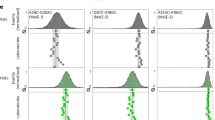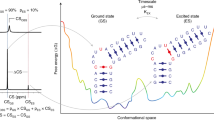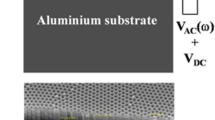Abstract
Molecular dynamics are essential for protein function. In some cases these dynamics involve the interconversion between ground state, highly populated conformers and less populated higher energy structures ('excited states') that play critical roles in biochemical processes. Here we describe recent advances in NMR spectroscopy methods that enable studies of these otherwise invisible excited states at an atomic level and that help elucidate their important relation to function. We discuss a range of examples from molecular recognition, ligand binding, enzyme catalysis and protein folding that illustrate the role that motion plays in 'funneling' conformers along preferred pathways that facilitate their biological function.
This is a preview of subscription content, access via your institution
Access options
Subscribe to this journal
Receive 12 print issues and online access
$259.00 per year
only $21.58 per issue
Buy this article
- Purchase on Springer Link
- Instant access to full article PDF
Prices may be subject to local taxes which are calculated during checkout






Similar content being viewed by others
References
Hammes, G.G. Mechanism of enzyme catalysis. Nature 204, 342–343 (1964).
Fersht, A.R. Structure and Mechanism in Protein Science (W.H. Freeman, New York, 1998).
Karplus, M. & Kuriyan, J. Molecular dynamics and protein function. Proc. Natl. Acad. Sci. USA 102, 6679–6685 (2005).
Perutz, M.F. & Mathews, F.S. An X-ray study of azide methaemoglobin. J. Mol. Biol. 21, 199–202 (1966).
Hvidt, A. & Linderstrom-Lang, K. Exchange of hydrogen atoms in insulin with deuterium atoms in aqueous solutions. Biochim. Biophys. Acta 14, 574–575 (1954).
Wüthrich, K. & Wagner, G. Internal motion in globular proteins. Trends Biochem. Sci. 3, 227–230 (1978).
Snyder, G.H., Rowan, R. III, Karplus, S. & Sykes, B.D. Complete tyrosine assignments in the high field 1H nuclear magnetic resonance spectrum of the bovine pancreatic trypsin inhibitor. Biochemistry 14, 3765–3777 (1975).
Campbell, I.D., Dobson, C.M. & Williams, R.J. Proton magnetic resonance studies of the tyrosine residues of hen lysozyme-assignment and detection of conformational mobility. Proc. R. Soc. Lond. B 189, 503–509 (1975).
Austin, R.H., Beeson, K.W., Eisenstein, L., Frauenfelder, H. & Gunsalus, I.C. Dynamics of ligand binding to myoglobin. Biochemistry 14, 5355–5373 (1975).
McCammon, J.A., Gelin, B.R. & Karplus, M. Dynamics of folded proteins. Nature 267, 585–590 (1977).
Tokuriki, N. & Tawfik, D.S. Protein dynamism and evolvability. Science 324, 203–207 (2009).
Bryngelson, J.D. & Wolynes, P.G. Spin glasses and the statistical mechanics of protein folding. Proc. Natl. Acad. Sci. USA 84, 7524–7528 (1987).
Chan, H.S. & Dill, K.A. Polymer principles in protein structure and stability. Annu. Rev. Biophys. Biophys. Chem. 20, 447–490 (1991).
Wolynes, P.G. Recent successes of the energy landscape theory of protein folding and function. Q. Rev. Biophys. 38, 405–410 (2005).
Hegler, J.A., Weinkam, P. & Wolynes, P.G. The spectrum of biomolecular states and motions. HFSP J. 2, 307–313 (2008).
Kay, L.E., Torchia, D.A. & Bax, A. Backbone dynamics of proteins as studied by 15N inverse detected heteronuclear NMR spectroscopy: application to staphylococcal nuclease. Biochemistry 28, 8972–8979 (1989).
Baber, J.L., Szabo, A. & Tjandra, N. Analysis of slow interdomain motion of macromolecules using NMR relaxation data. J. Am. Chem. Soc. 123, 3953–3959 (2001).
Rueda, M. et al. A consensus view of protein dynamics. Proc. Natl. Acad. Sci. USA 104, 796–801 (2007).
Dobson, C.M. & Karplus, M. Internal motion of proteins: nuclear magnetic resonance measurements and dynamic simulations. Methods Enzymol. 131, 362–389 (1986).
Peng, J.W. & Wagner, G. Investigation of protein motions via relaxation measurements. Methods Enzymol. 239, 563–596 (1994).
Palmer, A.G., Williams, J. & McDermott, A. Nuclear magnetic resonance studies of biopolymer dynamics. J. Phys. Chem. 100, 13293–13310 (1996).
Ishima, R. & Torchia, D.A. Protein dynamics from NMR. Nat. Struct. Biol. 7, 740–743 (2000).
Palmer, A.G., Grey, M.J. & Wang, C. Solution NMR spin relaxation methods for characterizing chemical exchange in high-molecular-weight systems. Methods Enzymol. 394, 430–465 (2005).
Henzler-Wildman, K. & Kern, D. Dynamic personalities of proteins. Nature 450, 964–972 (2007).
Mulder, F.A., Mittermaier, A., Hon, B., Dahlquist, F.W. & Kay, L.E. Studying excited states of proteins by NMR spectroscopy. Nat. Struct. Biol. 8, 932–935 (2001).
Mittag, T., Schaffhausen, B. & Gunther, U.L. Direct observation of protein-ligand interaction kinetics. Biochemistry 42, 11128–11136 (2003).
Tang, C., Iwahara, J. & Clore, G.M. Visualization of transient encounter complexes in protein-protein association. Nature 444, 383–386 (2006).
Iwahara, J. & Clore, G.M. Detecting transient intermediates in macromolecular binding by paramagnetic NMR. Nature 440, 1227–1230 (2006).
Sugase, K., Lansing, J.C., Dyson, H.J. & Wright, P.E. Tailoring relaxation dispersion experiments for fast-associating protein complexes. J. Am. Chem. Soc. 129, 13406–13407 (2007).
Sugase, K., Dyson, H.J. & Wright, P.E. Mechanism of coupled folding and binding of an intrinsically disordered protein. Nature 447, 1021–1025 (2007).
Tang, C., Schwieters, C.D. & Clore, G.M. Open-to-closed transition in apo maltose-binding protein observed by paramagnetic NMR. Nature 449, 1078–1082 (2007).
Korzhnev, D.M., Bezsonova, I., Lee, S., Chalikian, T.V. & Kay, L.E. Alternate binding modes for a ubiquitin-SH3 domain interaction studied by NMR spectroscopy. J. Mol. Biol. 386, 391–405 (2009).
Bruschweiler, S. et al. Direct observation of the dynamic process underlying allosteric signal transmission. J. Am. Chem. Soc. 131, 3063–3068 (2009)
Ishima, R., Freedberg, D.I., Wang, Y.-X., Louis, J.M. & Torchia, D.A. Flap opening and dimer-interface flexibility in the free and inhibitor-bound HIV protease, and their implications for function. Structure 7, 1047–1055 (1999).
Cole, R. & Loria, J.P. Evidence for flexibility in the function of ribonuclease A. Biochemistry 41, 6072–6081 (2002).
Eisenmesser, E.Z., Bosco, D.A., Akke, M. & Kern, D. Enzyme dynamics during catalysis. Science 295, 1520–1523 (2002).
Venkitakrishnan, R.P. et al. Conformational changes in the active site loops of dihydrofolate reductase during the catalytic cycle. Biochemistry 43, 16046–16055 (2004).
Wolf-Watz, M. et al. Linkage between dynamics and catalysis in a thermophilic-mesophilic enzyme pair. Nat. Struct. Mol. Biol. 11, 945–949 (2004).
Eisenmesser, E.Z. et al. Intrinsic dynamics of an enzyme underlies catalysis. Nature 438, 117–121 (2005).
Vallurupalli, P. & Kay, L.E. Complementarity of ensemble and single-molecule measures of protein motion: a relaxation dispersion NMR study of an enzyme complex. Proc. Natl. Acad. Sci. USA 103, 11910–11915 (2006).
Watt, E.D., Shimada, H., Kovrigin, E.L. & Loria, J.P. The mechanism of rate-limiting motions in enzyme function. Proc. Natl. Acad. Sci. USA 104, 11981–11986 (2007).
Kempf, J.G., Jung, J.Y., Ragain, C., Sampson, N.S. & Loria, J.P. Dynamic requirements for a functional protein hinge. J. Mol. Biol. 368, 131–149 (2007).
Tang, C., Louis, J.M., Aniana, A., Suh, J.Y. & Clore, G.M. Visualizing transient events in amino-terminal autoprocessing of HIV-1 protease. Nature 455, 693–696 (2008).
Hill, R.B., Bracken, C., DeGrado, W.F. & Palmer, A.G. Molecular motions and protein folding: characterization of the backbone dynamics and folding equilibrium of α2D using 13C NMR spin relaxation. J. Am. Chem. Soc. 122, 11610–11619 (2000).
Korzhnev, D.M. et al. Low-populated folding intermediates of Fyn SH3 characterized by relaxation dispersion NMR. Nature 430, 586–590 (2004).
Choy, W.Y., Zhou, Z., Bai, Y. & Kay, L.E. An 15N NMR spin relaxation dispersion study of the folding of a pair of engineered mutants of apocytochrome b562. J. Am. Chem. Soc. 127, 5066–5072 (2005).
Zeeb, M. & Balbach, J. Millisecond protein folding studied by NMR spectroscopy. Protein Pept. Lett. 12, 139–146 (2005).
Korzhnev, D.M., Neudecker, P., Zarrine-Afsar, A., Davidson, A.R. & Kay, L.E. Abp1p and Fyn SH3 domains fold through similar low-populated intermediate states. Biochemistry 45, 10175–10183 (2006).
Tang, Y., Grey, M.J., McKnight, J., Palmer, A.G. III & Raleigh, D.P. Multistate folding of the villin headpiece domain. J. Mol. Biol. 355, 1066–1077 (2006).
Neudecker, P. et al. Identification of a collapsed intermediate with non-native long-range interactions on the folding pathway of a pair of Fyn SH3 domain mutants by NMR relaxation dispersion spectroscopy. J. Mol. Biol. 363, 958–976 (2006).
Neudecker, P., Zarrine-Afsar, A., Davidson, A.R. & Kay, L.E. Phi-value analysis of a three-state protein folding pathway by NMR relaxation dispersion spectroscopy. Proc. Natl. Acad. Sci. USA 104, 15717–15722 (2007).
Korzhnev, D.M., Religa, T.L., Lundstrom, P., Fersht, A.R. & Kay, L.E. The folding pathway of an FF domain: characterization of an on-pathway intermediate state under folding conditions by (15)N, (13)C(alpha) and (13)C-methyl relaxation dispersion and (1)H/(2)H-exchange NMR spectroscopy. J. Mol. Biol. 372, 497–512 (2007).
Clore, G.M. Visualizing lowly-populated regions of the free energy landscape of macromolecular complexes by paramagnetic relaxation enhancement. Mol. Biosyst. 4, 1058–1069 (2008).
Carr, H.Y. & Purcell, E.M. Effects of diffusion on free precession in nuclear magnetic resonance experiments. Phys. Rev. 94, 630–638 (1954).
Meiboom, S. & Gill, D. Modified spin-echo method for measuring nuclear relaxation times. Rev. Sci. Instrum. 29, 688–691 (1958).
Solomon, I. Relaxation processes in a system of two spins. Phys. Rev. 99, 559–565 (1955).
Korzhnev, D.M. & Kay, L.E. Probing invisible, low-populated states of protein molecules by relaxation dispersion NMR spectroscopy: an application to protein folding. Acc. Chem. Res. 41, 442–451 (2008).
Lundstrom, P., Vallurupalli, P., Hansen, D.F. & Kay, L.E. Isotope labeling methods for studies of excited protein states by relaxation dispersion NMR spectroscopy. Nat. Protoc. (in the press).
Vallurupalli, P., Hansen, D.F. & Kay, L.E. Structures of invisible, excited protein states by relaxation dispersion NMR spectroscopy. Proc. Natl. Acad. Sci. USA 105, 11766–11771 (2008).
Clore, G.M. & Iwahara, J. Theory, practice, and applications of paramagnetic relaxation enhancement for the characterization of transient low-population states of biological macromolecules and their complexes. Chem. Rev. 109, 4108–4139 (2009).
Bai, Y., Sosnick, T., Mayne, L. & Englander, S. Protein folding intermediates: native-state hydrogen exchange. Science 269, 192–197 (1995).
Englander, S.W., Mayne, L. & Krishna, M.M. Protein folding and misfolding: mechanism and principles. Q. Rev. Biophys. 40, 287–326 (2007).
Smock, R.G. & Gierasch, L.M. Sending signals dynamically. Science 324, 198–203 (2009).
Verkhivker, G.M. et al. Complexity and simplicity of ligand-macromolecule interactions: the energy landscape perspective. Curr. Opin. Struct. Biol. 12, 197–203 (2002).
Lange, O.F. et al. Recognition dynamics up to microseconds revealed from an RDC-derived ubiquitin ensemble in solution. Science 320, 1471–1475 (2008).
Wolfenden, R. & Snider, M.J. The depth of chemical time and the power of enzymes as catalysts. Acc. Chem. Res. 34, 938–945 (2001).
Olsson, M.H., Parson, W.W. & Warshel, A. Dynamical contributions to enzyme catalysis: critical tests of a popular hypothesis. Chem. Rev. 106, 1737–1756 (2006).
Nagel, Z.D. & Klinman, J.P. A 21st century revisionist's view at a turning point in enzymology. Nat. Chem. Biol. 5, 543–550 (2009).
Pauling, L. Nature of forces between large molecules of biological interest. Nature 161, 707–709 (1948).
Hammes, G.G. Multiple conformational changes in enzyme catalysis. Biochemistry 41, 8221–8228 (2002).
Vamvaca, K., Vogeli, B., Kast, P., Pervushin, K. & Hilvert, D. An enzymatic molten globule: efficient coupling of folding and catalysis. Proc. Natl. Acad. Sci. USA 101, 12860–12864 (2004).
Roca, M., Messer, B., Hilvert, D. & Warshel, A. On the relationship between folding and chemical landscapes in enzyme catalysis. Proc. Natl. Acad. Sci. USA 105, 13877–13882 (2008).
Fierke, C.A., Johnson, K.A. & Benkovic, S.J. Construction and evaluation of the kinetic scheme associated with dihydrofolate reductase from Escherichia coli. Biochemistry 26, 4085–4092 (1987).
Boehr, D.D., McElheny, D., Dyson, H.J. & Wright, P.E. The dynamic energy landscape of dihydrofolate reductase catalysis. Science 313, 1638–1642 (2006).
Boehr, D.D., Dyson, H.J. & Wright, P.E. Conformational relaxation following hydride transfer plays a limiting role in dihydrofolate reductase catalysis. Biochemistry 47, 9227–9233 (2008).
Kubelka, J., Chiu, T.K., Davies, D.R., Eaton, W.A. & Hofrichter, J. Sub-microsecond protein folding. J. Mol. Biol. 359, 546–553 (2006).
Farrow, N.A., Zhang, O., Forman-Kay, J.D. & Kay, L.E. Comparison of the backbone dynamics of a folded and an unfolded SH3 domain existing in equilibrium in aqueous buffer. Biochemistry 34, 868–878 (1995).
Aronsson, G., Brorsson, A.-C., Sahlman, L. & Jonsson, B.-H. Remarkably slow folding of a small protein. FEBS Lett. 411, 359–364 (1997).
Zarrine-Afsar, A. et al. Theoretical and experimental demonstration of the importance of specific nonnative interactions in protein folding. Proc. Natl. Acad. Sci. USA 105, 9999–10004 (2008).
Plaxco, K.W. et al. The folding kinetics and thermodynamics of the Fyn-SH3 domain. Biochemistry 37, 2529–2537 (1998).
Di Nardo, A.A. et al. Dramatic acceleration of protein folding by stabilization of a nonnative backbone conformation. Proc. Natl. Acad. Sci. USA 101, 7954–7959 (2004).
Maity, H., Maity, M., Krishna, M.M., Mayne, L. & Englander, S.W. Protein folding: the stepwise assembly of foldon units. Proc. Natl. Acad. Sci. USA 102, 4741–4746 (2005).
Fersht, A.R. From the first protein structures to our current knowledge of protein folding: delights and scepticisms. Nat. Rev. Mol. Cell Biol. 9, 650–654 (2008).
Whittaker, S.B., Spence, G.R., Gunter Grossmann, J., Radford, S.E. & Moore, G.R. NMR analysis of the conformational properties of the trapped on-pathway folding intermediate of the bacterial immunity protein Im7. J. Mol. Biol. 366, 1001–1015 (2007).
Sprangers, R., Gribun, A., Hwang, P.M., Houry, W.A. & Kay, L.E. Quantitative NMR spectroscopy of supramolecular complexes: dynamic side pores in ClpP are important for product release. Proc. Natl. Acad. Sci. USA 102, 16678–16683 (2005).
Sprangers, R. & Kay, L.E. Quantitative dynamics and binding studies of the 20S proteasome by NMR. Nature 445, 618–622 (2007).
Loria, J.P., Rance, M. & Palmer, A.G.A. Relaxation-compensated (Carr Purcell Meiboom Gill) sequence for characterizing chemical exchange by NMR spectroscopy. J. Am. Chem. Soc. 121, 2331–2332 (1999).
Tollinger, M., Skrynnikov, N.R., Mulder, F.A., Forman-Kay, J.D. & Kay, L.E. Slow dynamics in folded and unfolded states of an SH3 domain. J. Am. Chem. Soc. 123, 11341–11352 (2001).
Ishima, R. & Torchia, D.A. Extending the range of amide proton relaxation dispersion experiments in proteins using a constant-time relaxation-compensated CPMG approach. J. Biomol. NMR 25, 243–248 (2003).
Lundstrom, P. et al. Fractional 13C enrichment of isolated carbons using [1–13C]- or [2- 13C]-glucose facilitates the accurate measurement of dynamics at backbone Calpha and side-chain methyl positions in proteins. J. Biomol. NMR 38, 199–212 (2007).
Hansen, D.F., Vallurupalli, P., Lundstrom, P., Neudecker, P. & Kay, L.E. Probing chemical shifts of invisible states of proteins with relaxation dispersion NMR spectroscopy: how well can we do? J. Am. Chem. Soc. 130, 2667–2675 (2008).
Ishima, R., Baber, J., Louis, J.M. & Torchia, D.A. Carbonyl carbon transverse relaxation dispersion measurements and ms-micros timescale motion in a protein hydrogen bond network. J. Biomol. NMR 29, 187–198 (2004).
Vallurupalli, P., Hansen, D.F., Stollar, E., Meirovitch, E. & Kay, L.E. Measurement of bond vector orientations in invisible excited states of proteins. Proc. Natl. Acad. Sci. USA 104, 18473–18477 (2007).
Hansen, D.F., Vallurupalli, P. & Kay, L.E. Quantifying two-bond 1HN-13CO and one-bond 1H(alpha)-13C(alpha) dipolar couplings of invisible protein states by spin-state selective relaxation dispersion NMR spectroscopy. J. Am. Chem. Soc. 130, 8397–8405 (2008).
Baldwin, A., Hansen, D.F., Vallurupalli, P. & Kay, L.E. Measurement of methyl axis orientations in invisible, excited states of proteins by relaxation dispersion NMR spectroscopy. J. Am. Chem. Soc. 131, 11939–11948 (2009).
Vallurupalli, P., Hansen, D.F. & Kay, L.E. Probing structure in invisible protein states with anisotropic NMR chemical shifts. J. Am. Chem. Soc. 130, 2734–2735 (2008).
Hansen, D.F., Vallurupalli, P. & Kay, L.E. Using relaxation dispersion NMR spectroscopy to determine the structures of excited, invisible protein states. J. Biomol. NMR 41, 113–120 (2008).
Lippens, G., Caron, L. & Smet, C. A microscopic view of chemical exchange: Monte Carlo simulation of molecular association. Concepts Magn. Reson. A 21A, 1–9 (2004).
Skrynnikov, N.R., Dahlquist, F.W. & Kay, L.E. Reconstructing NMR spectra of “invisible” excited protein states using HSQC and HMQC experiments. J. Am. Chem. Soc. 124, 12352–12360 (2002).
Acknowledgements
This work was supported by grants from the Natural Sciences and Engineering Research Council of Canada and the Canadian Institutes of Health Research (CIHR). The authors are grateful to Y. Bai (US National Cancer Institute) for providing Figure 6b. A.J.B. acknowledges support in the form of European Molecular Biology Organization and CIHR postdoctoral fellowships.
Author information
Authors and Affiliations
Corresponding author
Rights and permissions
About this article
Cite this article
Baldwin, A., Kay, L. NMR spectroscopy brings invisible protein states into focus. Nat Chem Biol 5, 808–814 (2009). https://doi.org/10.1038/nchembio.238
Published:
Issue Date:
DOI: https://doi.org/10.1038/nchembio.238
This article is cited by
-
Excited-state observation of active K-Ras reveals differential structural dynamics of wild-type versus oncogenic G12D and G12C mutants
Nature Structural & Molecular Biology (2023)
-
Predicting protein function and orientation on a gold nanoparticle surface using a residue-based affinity scale
Nature Communications (2022)
-
Ligand-induced structural transitions combined with paramagnetic ions facilitate unambiguous NMR assignments of methyl groups in large proteins
Journal of Biomolecular NMR (2022)
-
Modeling Catalysis in Allosteric Enzymes: Capturing Conformational Consequences
Topics in Catalysis (2022)
-
Removal of 2H-decoupling sidebands in 13CHD2 13C-CEST profiles
Journal of Biomolecular NMR (2021)



